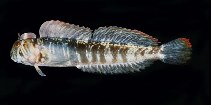| Family: |
Blenniidae (Combtooth blennies), subfamily: Salariinae |
| Max. size: |
5.9 cm SL (male/unsexed) |
| Environment: |
demersal; marine |
| Distribution: |
Western Pacific: southern Japan, Taiwan, and Guam. |
| Diagnosis: |
Dorsal spines (total): 13-13; Dorsal soft rays (total): 17-19; Anal spines: 2-2; Anal soft rays: 18-19. Nasal cirrus simple and supraorbital cirrus long, a little pinnate. Nuchal cirrus absent. Occipital crest in male, none in female. Some oblique lines distinct on cheek. |
| Biology: |
Adults inhabit surge, rocky shore areas. Grow to less than 14 cm TL. Oviparous. Eggs are demersal and adhesive (Ref. 205), and are attached to the substrate via a filamentous, adhesive pad or pedestal (Ref. 94114). Larvae are planktonic, often found in shallow, coastal waters (Ref. 94114). |
| IUCN Red List Status: |
Least Concern (LC); Date assessed: 27 March 2009 Ref. (130435)
|
| Threat to humans: |
harmless |
Source and more info: www.fishbase.org. For personal, classroom, and other internal use only. Not for publication.
